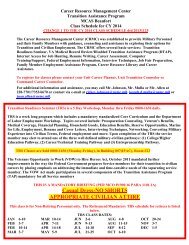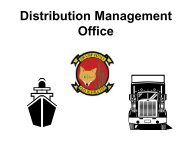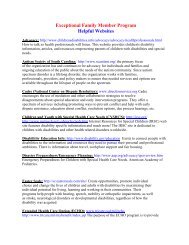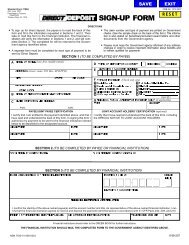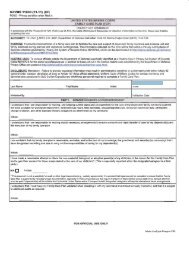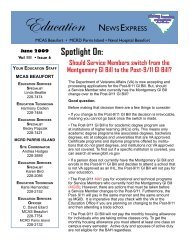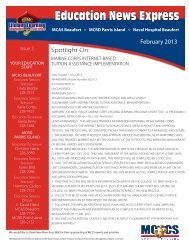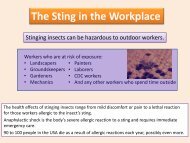navmc dir 5100.8 marine corps occupational safety and ... - US Navy
navmc dir 5100.8 marine corps occupational safety and ... - US Navy
navmc dir 5100.8 marine corps occupational safety and ... - US Navy
Create successful ePaper yourself
Turn your PDF publications into a flip-book with our unique Google optimized e-Paper software.
MARCOR OSH PROGRAM MANUAL 17008Corps inventory unless approved per NAVSEA 9310.1B <strong>and</strong> NAVSEAS9310-AQ-SAF-010.b. When lithium batteries are approved for use within theMarine Corps, installations must package, h<strong>and</strong>le, store,transport, use <strong>and</strong> dispose of them in a manner that willminimize the dangers of fire, explosion, <strong>and</strong> adverse impacts tohuman health caused by hazardous substance releases to theenvironment. Tenant comm<strong>and</strong>s shall have a central control pointfor lithium battery storage, issue, <strong>and</strong> collection.Installations <strong>and</strong> tenant comm<strong>and</strong>s shall comply with allapplicable laws, regulations, <strong>and</strong> this Manual. Figure 17-1provides lithium battery information <strong>and</strong> guidance documents.2. Marine Corps Lithium Batteriesa. Lithium-sulfur dioxide (LiSO 2 ). LiSO 2 batteries containpressurized sulfur dioxide gas <strong>and</strong> are used extensively formilitary applications, especially in communications <strong>and</strong>electronics equipment. The gas is highly toxic, <strong>and</strong> the batteryshould not be h<strong>and</strong>led in any way that may cause the battery torupture. These high performance batteries contain highlyreactive materials <strong>and</strong> require proper treatment duringpackaging, h<strong>and</strong>ling, storage, transportation, operation, <strong>and</strong>disposal. LiSO 2 batteries should be considered hazardous at alltimes <strong>and</strong>, when no longer suitable for use, managed <strong>and</strong> disposedof as hazardous waste unless fully discharged in accordance withthis Manual (see paragraph 17006.5); U.S. Army TechnicalBulletin TB 43—134, Battery Disposition <strong>and</strong> Disposal; U.S. ArmySupply Bulletin SB 11-6 on CECOM-Managed Battery Supply <strong>and</strong>Management Data; <strong>and</strong> U.S. Army CECOM Safety Compact Disk (CD) onLithium Battery Safety. Only BA-5567/U batteries are consideredas non-hazardous solid waste (NHSW) for disposal purposes.b. Lithium-thionyl chloride (LiSOCl 2 ). LiSOC1 2 batteriescontain liquid thionyl chloride. Damaged or ruptured batteriesmay expose their liquid thionyl chloride to humid air to formacidic vapors that are highly toxic. LiSOCl 2 batteries must notbe abused in any way that may cause them to rupture. Thesebatteries should be considered hazardous at all times <strong>and</strong>, whenno longer suitable for use, managed <strong>and</strong> disposed of as hazardouswaste.17-9



